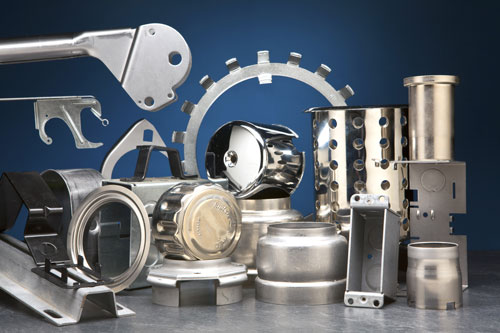How to Optimize the Design of Your Parts
Precision Metal Stamping can provide components that feature strength, durability, wear resistance, stability, and good conductive properties. It is also an economical way to produce high volumes of parts with consistent quality. The stamping process yields some elements that can be used to your advantage if incorporated into your design. Understanding how the process works and what to expect is key to optimizing these features.
Major on the Majors, Minor on the Minors
 Since, in many cases, pierced holes or blanked edges can be done in one step in a stamping die, they can be held to tight tolerances. But if features need to be pierced in separate operations or stations, across formed features or on different planes, tolerances need to allow for these added variables. Likewise, although sheet metal is theoretically flat, many factors such as coil set and the compressive forces of punching and forming will distort the finished part and affect tolerances as well. We encourage our customers to start a conversation early in the design process to discuss the function of the part, the stamping process, and your performance requirements.
Since, in many cases, pierced holes or blanked edges can be done in one step in a stamping die, they can be held to tight tolerances. But if features need to be pierced in separate operations or stations, across formed features or on different planes, tolerances need to allow for these added variables. Likewise, although sheet metal is theoretically flat, many factors such as coil set and the compressive forces of punching and forming will distort the finished part and affect tolerances as well. We encourage our customers to start a conversation early in the design process to discuss the function of the part, the stamping process, and your performance requirements.
That’s Gonna Leave a Mark
The forces required to bend and shape metal leave their marks on the finished piece, and some form of cosmetic mark is left behind. These tooling marks are a normal part of the metal forming process. However, when cosmetics are important, these marks can be minimized by the use of creative tooling techniques and careful die design. It is most helpful to know what the application is, and what the cosmetic requirements are. Whenever possible, cosmetic specifications should be described on the part drawing.
About Deep Draw
Deep draw is a very specialized process in metal stamping requiring properly equipped press equipment and engineering expertise. Performed under very controlled and calculated conditions, it involves pulling a flat “blank” of material over a radiused die edge and into a cavity, producing a closed bottom, round or irregularly shaped cup or cylinder. There are some considerations to keep in mind with deep draw.
Specifying a Drawn Shell
A flat blank of metal is put under extreme stress as it goes from the flat to a cylindrical shape. Not all materials lend themselves well to the deep draw process. Tensile and yield strengths must be considered when choosing a material for a deep drawn product. Complex shapes can be produced using the deep draw process, but it does have its limitations. Multiple diameters, steps, “collars,” flanges, and tightly radiused corners are usually formed in multiple stations or operations. This all should be considered when specifying and tolerancing the finished part. It is always best to open a dialogue with our engineering staff while in the design stages of product development. We can assist in choosing a material and design features that will result in a stable, consistent product.
It’s all about Choices
Metal stampings can be made from a wide variety of materials to suit the performance requirements of your product. But not all alloys and grades of material are economical or readily available. Some of the more specialized alloys and gages require sourcing from custom suppliers or result in spot-buys from the marketplace which can result in inconsistent performance. Also, if a custom grade of materials has to be special-ordered, it usually requires a large minimum order and results in longer lead times. Most of the time, the more commonly available materials will have all the performance features you need, and at a fraction of the cost of more exotic and expensive grades.
Larson Tool works collaboratively with companies of all sizes, providing guidance and cost-effective, high-quality results with everything from precision metal stamping and forming to deep draw stamping. The information provided here is part of a larger discussion we provide in our downloadable Metal Stamping Design Guidelines. Find out more about the design guidelines that will help us create your parts—just the way you need them to look and perform—by downloading it now.

